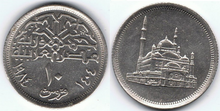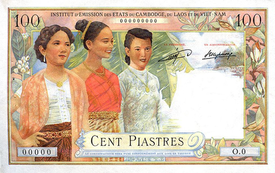
Back Пиастър Bulgarian Piastra Catalan Piaster German Piastro Esperanto Piaster Estonian Piasteri Finnish Piastre French Piastre Hausa Piastre ID Piastre IG
This article needs additional citations for verification. (July 2010) |



The piastre or piaster (English: /piˈæstər/) is any of a number of units of currency. The term originates from the Italian for "thin metal plate". The name was applied to Spanish and Hispanic American pieces of eight, or pesos, by Venetian traders in the Levant in the 16th century.
These pesos, minted continually for centuries, were readily accepted by traders in many parts of the world. After the countries of Latin America had gained independence, pesos of Mexico began flowing in through the trade routes, and became prolific in the Far East, taking the place of the Spanish pieces of eight which had been introduced by the Spanish at Manila, and by the Portuguese at Malacca. When the French colonised Indochina, they began issuing the new French Indochinese piastre (piastre de commerce), which was equal in value to the familiar Spanish and Mexican pesos.
In the Ottoman Empire, the word piastre was a colloquial European name of Kuruş. Successive currency reforms had reduced the value of the Ottoman piastre by the late 19th century so as to be worth about two pence (2d) sterling. Hence the name piastre referred to two distinct kinds of coins in two distinct parts of the world, both of which had descended from the Spanish pieces of eight.
Because of the debased values of the piastres in the Middle East, these piastres became subsidiary units for the Turkish, Cypriot, and Egyptian pounds.[1] Meanwhile, in Indochina, the piastre continued into the 1950s and was subsequently renamed the riel, the kip, and the dong in Cambodia, Laos and Vietnam respectively.
- ^ Thimm, Carl Albert. "Egyptian Money". Egyptian Self-Taught. William Brown & Co., Ltd., St. Mary Axe, London, E.C.
{{cite book}}:|website=ignored (help)
© MMXXIII Rich X Search. We shall prevail. All rights reserved. Rich X Search